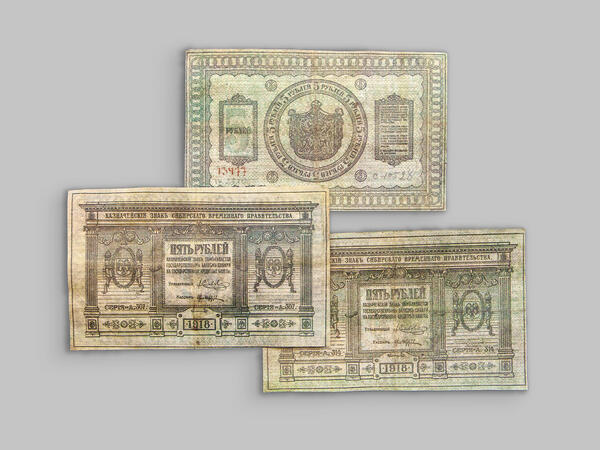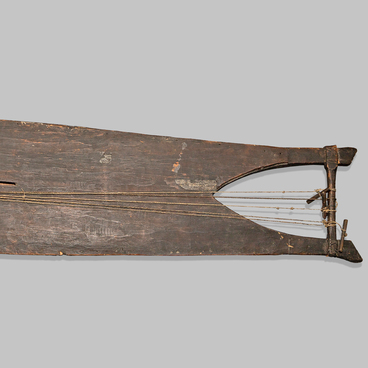Banknote of the Provisional Siberian Government with a nominal value of 5 rubles is a monetary unit issued in Omsk in 1918-1919 by the leader of the White movement, the Supreme Ruler of Russia, Admiral Alexander Kolchak. The printed money was supposed to improve the financial situation of Siberia.
This monetary system has become widespread in the Volga Region, the Urals, Siberia, Transbaikalia, the Far East, and Manchuria. Artists who designed banknotes were guided by how money looked like under Emperor Nicholas II. The inscription ‘Banknote of the Provisional Siberian Government’ was placed across the obverse in the upper part of the banknote, and a round medallion with the emblem of the Provisional Siberian Government was placed on the reverse in the center. The emblem depicted a shield with two sables and a double-headed eagle on the background of the rolled-out mantle.
Banknotes stored in the museum were transferred by Admiral Alexander Kolchak to the Tobolsk Provincial Museum during his visit on October 11, 1919. After having learned about the museum’s plight, Kolchak ordered to allocate 15 thousand rubles, which he personally handed over to the permanent member of the museum Mr. Koryakov. The money was enough for firewood and for the salary of employees for six months. But on October 26, power again passed to the Bolsheviks, and the money donated by Kolchak became invalid. In memory of a bygone era, the Museum Committee transferred money to the Numismatic Fund of the Tobolsk Museum.
In addition to the five-ruble banknote of the Provisional Siberian Government, five-percent loan bonds, a series of 1-ruble and 10-ruble change banknotes, and the subsequent 3-ruble and 300-ruble banknotes were issued into circulation. They became a logical continuation of the previous emission of banknotes by the Provisional Siberian Government. These banknotes included the coat of arms of Siberia with two sables and arrows.
Alexander Kolchak was a Russian military and political figure, naval commander, oceanographer, and polar explorer. He was a participant of the Russian-Japanese War. During World War I, Kolchak commanded the mine division of the Baltic fleet and the Black Sea fleet. He was a leader of the White movement during the Civil War, supreme ruler of Russia from 1918 to 1920, and a supreme commander of the Russian army.
This monetary system has become widespread in the Volga Region, the Urals, Siberia, Transbaikalia, the Far East, and Manchuria. Artists who designed banknotes were guided by how money looked like under Emperor Nicholas II. The inscription ‘Banknote of the Provisional Siberian Government’ was placed across the obverse in the upper part of the banknote, and a round medallion with the emblem of the Provisional Siberian Government was placed on the reverse in the center. The emblem depicted a shield with two sables and a double-headed eagle on the background of the rolled-out mantle.
Banknotes stored in the museum were transferred by Admiral Alexander Kolchak to the Tobolsk Provincial Museum during his visit on October 11, 1919. After having learned about the museum’s plight, Kolchak ordered to allocate 15 thousand rubles, which he personally handed over to the permanent member of the museum Mr. Koryakov. The money was enough for firewood and for the salary of employees for six months. But on October 26, power again passed to the Bolsheviks, and the money donated by Kolchak became invalid. In memory of a bygone era, the Museum Committee transferred money to the Numismatic Fund of the Tobolsk Museum.
In addition to the five-ruble banknote of the Provisional Siberian Government, five-percent loan bonds, a series of 1-ruble and 10-ruble change banknotes, and the subsequent 3-ruble and 300-ruble banknotes were issued into circulation. They became a logical continuation of the previous emission of banknotes by the Provisional Siberian Government. These banknotes included the coat of arms of Siberia with two sables and arrows.
Alexander Kolchak was a Russian military and political figure, naval commander, oceanographer, and polar explorer. He was a participant of the Russian-Japanese War. During World War I, Kolchak commanded the mine division of the Baltic fleet and the Black Sea fleet. He was a leader of the White movement during the Civil War, supreme ruler of Russia from 1918 to 1920, and a supreme commander of the Russian army.



